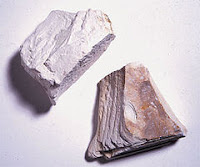Hello! Welcome to my Rocks and Minerals Virtual Tour. On this tour we are going to be visiting the state of Georgia and learning a bit about it's rocks and minerals.
The ten stops that we will be taking today are to observe the rocks and minerals:
- Perlite
- Iron oxcide
- Kaolin
- Fullers' Earth
- Cement
- Feldspar
- Mica
- Silicom
- Dimension stone
- Industrial sand & gravel.
On this tour we will also learn a bit about igneous rocks, metamorphic rocks and sedimentary rocks.
Igneous rocks are rocks that form when magma cools and crystallizes. Many igneous rocks often look glassy, since the magma and crystals close to the Earth's surface doesn't have enough time too form. Some igneous rocks may also have bubbles or bumps in them, this is caused by trapped air within the rock.
Metamorphic rocks are formed when certain minerals and stones undergo extreme changes in temperature and pressure. Many types of metamorphic rocks contain mica, and that's one of the minerals that will be studying today! Metamorphic rocks have a shiny and sparkly tone to them.
Sedimentary rocks are made up of small or large pieces of other rocks that are cemented together by weathering and/or erosion. Some sedimentary rocks can be made up of different types of rock. Almost all fossils are always found in a sedimentary rock.










